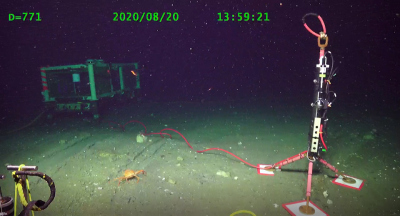- Home
- Discover
- Archive News
- News 2021
- Deep Sea dive OOI
Follow a live dive
The dives can be followed live on the Internet so that the MARUM team can monitor part of the work from Germany. Already today, a first dive should start as soon as the still rough sea allows it.
Due to the corona situation, the MARUM team could not participate in the annual maintenance expedition. Instead, colleagues from the University of Washington are taking over the work at sea.
MARUM's equipment will allow researchers to monitor and quantify the natural release of methane from the ocean floor in one of the most active methane seeps from the Oregon continental margin in the northeast Pacific in real time and over several years.
Participation in the observatory is part of the M³ project for acoustic monitoring of the natural release of methane gas from the ocean floor. The project is fully funded by the German Federal Ministry of Education and Research (BMBF) and is funded until April 2023.



